



Call Silver Star at 828-321-4268
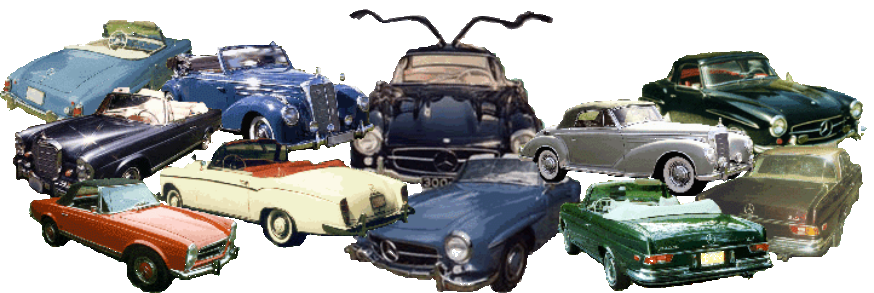

190SL Roadster 1955-1963

HISTORY of the 190SL
The Road & Track October 1955 Test said "The outstanding achievement of the 190SL is without a doubt
its quality in design and workmanship. But a close second is the general feeling of solidity which it
immediately conveys..."
Also known as "Baby Merc" or the “Little Brother” to the 300 SL, 190 SL’s make a great and fun collector
automobile, and are relatively affordable. The car came as a coupe (with a detachable hardtop) or a
roadster with convertible top to which a hardtop could be fitted. These cars were guaranteed to sell to
enthusiasts who couldn't stretch to a Gullwing and didn't need the electrifying performance of a
Gullwing. Although the 190SL shared the same wheelbase as the 300SL, a number of it's major
components came from the 180 Saloon. Several modifications were made between the unveiling of the
prototype in New York at the New York Motor Show and the beginning of production in the Spring of
1955. The first uni body Mercedes Benz used a steel chassis with aluminum hood, trunk lid, doors and
dash. Even with those aluminum pieces, it was a heavy car, weighing in at almost 2600 lbs!
190SL Production Changes
April 1955
•
Dashboard modified to improve accessibility of switches under steering wheel
•
From engine 11, cylinder head gasket changed from 1.5mm to 1.7 mm
•
Locking lever for backrests modified
•
Rear axle ratio now 3.89:1
July 1955
•
Cigarette lighter with shrouded element, and element diameter increased from 21mm to 22mm
•
Moldings fitted to windows and instrument panel changed from clamp to screw fastening
•
Clutch operating lever modified
August 1955
•
Impressing of glovebox lid by pressing tool
November 1955
•
Fuel filler pipe at tank inlet cut off straight
December 1955
•
For coupe, rear wheel arch eyebrows fitted with decorative moldings; optional on roadster
•
Rivets on soft top replaced by fasteners
•
Interior door panels fastened with clips instead of screws
January 1956
•
Rubber cover for accelorater pad (was bare steel)
•
New ashtray with rotating base
February 1956
•
Modified jacking points
•
Coupe roof material changed from aluminum to pressed steel
March 1956
•
Narrow upper door trim molding strip on coupe replaced by wider chrome rail, also fitted to Roadster; glovebox lid
with lock now standard
•
Coupe and roadster interior door panels now standardized
•
New ignition switch 545 1413
April 1956
•
Renk radiator cap with 1 bar opening pressure
•
Headlight flasher function standard
•
Fresh air blower on driver's side, second bosch horn, brake servo ATE T50 standard
June 1956
•
Larger rear lights from 220a and 220S saloon fitted (except chassis 2680, 2683, and 2701)
January 1957
•
Convex taillight lenses fitted
February 1957
•
Modified interior door handles
July 1957
•
Number plate lights fitted in bumper overriders
October 1957
•
Red instead of amber indicator lenses for U.S. market
January 1958
•
For U.S. cars, dividing strip between stop and tail lights removed.
July 1958
•
New indicator and park lights for U.S. versions
January 1959
•
Lockable fuel tank cap shares key with door locks
October 1959
•
Coupe hard-top with larger rear window
•
Roadster hard-top with larger rear window
February 1960
•
Paint number plate moved from engine compartment and combined with body number plate on left front door
pillar; body number continues to be stamped into engine firewall
October 1961
•
Seat belt anchorage points fitted
January 1962
•
Bosch horns limited to 100 decibels
February 1962
•
Mounting holes for seat belts on transmission tunnel closed with sealing plugs
May 1962
•
Front wheel arches sprayed with PVC for protection against corrosion
July 1962
•
Foglamps with yellow reflector instead of yellow glass
Production Numbers:
Production Numbers of the 190SL from 1955 until 1963
190SL coupe (hard top only) vin prefix - 121 040
roadster (soft top only) vin prefix - 121 042
Engine prefix - 121 921
mid 1961 saw the engine prefix change to 121 928
1955
1727 units
1956
4032 units
1957
3332 units
1958
2722 units
1959
3949 units
1960
3977 units
1961
3792 units
1962
2246 units
1963
104 units
Total:
25881 units


Buying A 190SL
Know what you're buying and what to look for and know what to avoid.
When these cars are well maintained and properly taken care of, they increase in value.
PLEASE READ THIS FIRST!
A car's value is determined by condition. Standard condition guidelines are as follows:
Excellent- As close to perfect original or a very well restored vehicle. Generally a body-off restoration, but
a well done body-on restoration that has been fully detailed may qualify. The vehicle is stunning to look at.
Everything works as new, all equipment is original, NOS or excellent quality reproductions. PLEASE KEEP IN
MIND THAT # 1 CARS ARE VERY RARE, AND ARE ORIGINAL RIGHT DOWN TO THE HOSE CLAMPS. DO NOT
ASSUME THAT JUST BECAUSE A CAR HAS A #1 ASKING PRICE, THAT IT IS IN # 1 CONDITION. MOST CARS FOR
SALE OUT THERE ARE LOW # 2 TO HIGH # 3 CARS.
Very Good- An extremely presentable vehicle showing minimal wear, or a well restored vehicle. Runs and
drives smooth and tight. Needs no mechanical or cosmetic work. All areas have been detailed. Beautiful to
look at but clearly not a # 1 vehicle.
Good- Presentable inside and out with some signs of wear. Not detailed but clean. Body should be straight
and solid with no rust-through anywhere. Shiny, attractive paint but may have evidence of minor fading or
checking or other imperfections. Runs and drives well but may need some minor mechanical or cosmetic
work. But it is useable and enjoyable as is.
Fair- Runs and drives ok but needs work throughout the vehicle. Body shows signs of wear or previous
restoration work. Any rust should be minimal and not in any structural areas. Cosmetics, body and
mechanicals all need work to some degree.
Poor- In need of complete restoration, but is complete and not a rust bucket beyond repair. May or may not
run but is not roadworthy.
These values are from Collector Car Market Review and are based on actual sales of vehicles,
not on asking prices of vehicles. Asking prices, and sales prices are very different.
Currently: (these are approximate values based on actual sales of vehicles.) Prices last updated Sept 2019
190 SL
# 5
# 4
# 3
# 2
# 1
Roadster
$25,500.00
$52,500.00
$83,000.00
$113,000.00
$150,300.00












Keep in mind that due to the high cost of restoration, mint examples of these cars can and
have sold for more than the prices quoted here.
Once the mechanical parts are sorted out, this is basically a bullet proof car. The only trouble spots are the
Solex carburetors and the old-fashioned T-50 power brake boosters. The 190 SL’s are very rust prone so
they must be checked thoroughly at the following places: (see photos below for reference)
•
all four jack points
•
the mounts for the rear trailing arms
•
floors
•
the spare tire well in the trunk
•
under the brake booster and the battery tray
•
the front fenders tend to get rusty around the headlights
•
the eyebrows above all four wheels
•
spaces behind the front and rear wheels also tend to rust
Make sure the car you purchase is complete. You do not want to buy a basket case, there are plenty of
these cars out there, so make sure it has complete sheetmetal. Mechanical parts for this car are available,
however, some of the chrome plated items will cost you if you can find them. 190 SL’s are a very simple car
and therefore are easy and affordable to maintain. To completely restore one can of course be a costly
affair, but once it is done, it is a very enjoyable automobile with lots of style. Condition of a car CANNOT be
determined by its location. Don't be fooled by a car's current geographical location. Just because a car is in
California today, does not mean that is where it started life.
Where to find the engine number and
chassis number.
Check the VIN number.
You will find the VIN number on a plate on the
right side firewall and stamped on the frame
near the voltage regulator.
A small plate with the same information is just
above. The engine number is on a data plate on
the left side of the engine near the cylinder
head. (See diagram.)

The chassis prefix for a 190 SL Coupe is 121 040.
The engine prefix is 121 921.**
The chassis prefix for a 190 SL Roadster is 121 040.
The engine prefix is 121 921.**
** mid 1961 saw the engine prefix change to 121 928
Look at the car in general. Walk around the car several times looking at the gaps for the doors, trunk and
hood. Look at the general overall condition of the car. Ask the current owner for all the documentation he
has on the car. The more information you have, the easier your purchase decision will be. The best tool to
use for checking the condition of body panels are your hands.
RUST is of course the enemy. 190 SL's were rust prone from the beginning and were never adequately
protected from the "monster that never sleeps". Always put your intended purchase on a lift, up in the air to
fully inspect (and poke if necessary) the bottom undercarriage of the car. Any owner who won't allow this
may have something to hide. Luckily the hood, trunklid and doors are aluminum.
Look for rust in the following places.


Technical Specifications
Engine Type:
4 cylinder (M121)
Bore and stroke:
85 x 83.6mm
Displacement:
1897 cc
Power output:
105 hp (DIN) @ 5700 rpm
Compression ratio:
8.5:1
Torque:
14.5 mkg @ 3200 rpm (104.9 ft/lb)
Carburetion:
2 dual downdraft carburetor Solex 44 PHH
Engine speed at 100km/hr:
3350 rpm
Gear ratios:
I. 352:1
II. 2.32:1
III.1.52:1
IV.1.00:1
Rear axle ratio:
3.90
Chassis:
unit frame and body
Suspension:
independent front, single joint swing axle rear, with coil springs
Brakes and area:
drum, 1064sq cm (servo optional)
Wheelbase:
2400 mm (112 inches)
Track front/rear:
1430/1475 mm (56.2/58.1 in)
Length:
4220 mm (166.1 inches)
Width:
1740 mm (68.5 inches)
Height:
1320 mm (52inches)
Ground clearance:
185 mm (7.3 inches)
Tires:
6.4 x 13 sport
Turning circle:
11 meters (36.1 feet)
Steering type and ratio:
recirculating ball, 18.5:1
Weight:
roadster: 2552 lbs
coupe: 2596 lbs
Maximum speed:
106 mph
Acceleration:
14.5 sec 0-100 km
Fuel consumption:
12.5 liters/100km (18.75 mpg)
Fuel tank capacity:
65 liters (17 gal.)
































































- 220 Cabriolet A and 220 Cabriolet B 1951-1955
- 300 -300b -300c - 300d Convertible Sedan 1951-1962
- 300S - 300Sc Cabriolet / Coupe / Roadster 1951-1958
- 300SL Gullwing and Roadster 1954-1962
- 190SL Roadsters 1955-1963
- 220S / 220SE Cabriolets & Coupes 1956-1960
- 300SE Cabriolets & Coupes 1962-1967
- 220SEb/250SE/280SE/280SE 3.5 Cabriolets & Coupes 1961-1971
- 230SL/250SL/280SL Roadsters 1963-1971
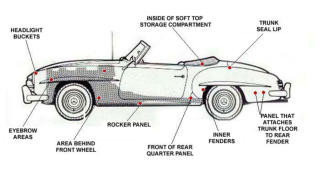


© Silver Star Restorations is an independent shop and is
not affiliated with Mercedes Benz of North American or
Daimler Benz AG


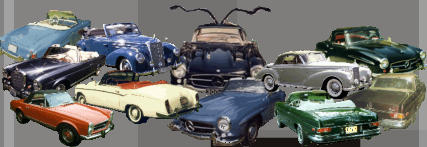
call Silver Star at 828-321-4268
190SL Roadster 1955-1963

HISTORY of the 190SL
The Road & Track October 1955 Test said "The outstanding
achievement of the 190SL is without a doubt its quality in design
and workmanship. But a close second is the general feeling of
solidity which it immediately conveys..."
Also known as "Baby Merc" or the “Little Brother” to the 300 SL,
190 SL’s make a great and fun collector automobile, and are
relatively affordable. The car came as a coupe (with a detachable
hardtop) or a roadster with convertible top to which a hardtop
could be fitted. These cars were guaranteed to sell to
enthusiasts who couldn't stretch to a Gullwing and didn't need
the electrifying performance of a Gullwing. Although the 190SL
shared the same wheelbase as the 300SL, a number of it's major
components came from the 180 Saloon. Several modifications
were made between the unveiling of the prototype in New York
at the New York Motor Show and the beginning of production in
the Spring of 1955. The first uni body Mercedes Benz used a
steel chassis with aluminum hood, trunk lid, doors and dash.
Even with those aluminum pieces, it was a heavy car, weighing in
at almost 2600 lbs!
190SL Production Changes
April 1955
•
Dashboard modified to improve accessibility of switches under
steering wheel
•
From engine 11, cylinder head gasket changed from 1.5mm to 1.7
mm
•
Locking lever for backrests modified
•
Rear axle ratio now 3.89:1
July 1955
•
Cigarette lighter with shrouded element, and element diameter
increased from 21mm to 22mm
•
Moldings fitted to windows and instrument panel changed from
clamp to screw fastening
•
Clutch operating lever modified
August 1955
•
Impressing of glovebox lid by pressing tool
November 1955
•
Fuel filler pipe at tank inlet cut off straight
December 1955
•
For coupe, rear wheel arch eyebrows fitted with decorative
moldings; optional on roadster
•
Rivets on soft top replaced by fasteners
•
Interior door panels fastened with clips instead of screws
January 1956
•
Rubber cover for accelorater pad (was bare steel)
•
New ashtray with rotating base
February 1956
•
Modified jacking points
•
Coupe roof material changed from aluminum to
pressed steel
March 1956
•
Narrow upper door trim molding strip on coupe replaced by wider
chrome rail, also fitted to Roadster; glovebox lid with lock now
standard
•
Coupe and roadster interior door panels now standardized
•
New ignition switch 545 1413
April 1956
•
Renk radiator cap with 1 bar opening pressure
•
Headlight flasher function standard
•
Fresh air blower on driver's side, second bosch horn, brake servo
ATE T50 standard
June 1956
•
Larger rear lights from 220a and 220S saloon fitted (except
chassis 2680, 2683, and 2701)
January 1957
•
Convex taillight lenses fitted
February 1957
•
Modified interior door handles
July 1957
•
Number plate lights fitted in bumper overriders
October 1957
•
Red instead of amber indicator lenses for U.S. market
January 1958
•
For U.S. cars, dividing strip between stop and tail lights removed.
July 1958
•
New indicator and park lights for U.S. versions
January 1959
•
Lockable fuel tank cap shares key with door locks
October 1959
•
Coupe hard-top with larger rear window
•
Roadster hard-top with larger rear window
February 1960
•
Paint number plate moved from engine compartment and
combined with body number plate on left front door pillar; body
number continues to be stamped into engine firewall
October 1961
•
Seat belt anchorage points fitted
January 1962
•
Bosch horns limited to 100 decibels
February 1962
•
Mounting holes for seat belts on transmission tunnel closed with
sealing plugs
May 1962
•
Front wheel arches sprayed with PVC for protection against
corrosion
July 1962
•
Foglamps with yellow reflector instead of yellow glass
Production Numbers:
Production Numbers of the 190SL from 1955 until 1963
190SL coupe (hard top only) vin prefix - 121 040
roadster (soft top only) vin prefix - 121 042
Engine prefix - 121 921
mid 1961 saw the engine prefix change to 121 928
1955
1727 units
1956
4032 units
1957
3332 units
1958
2722 units
1959
3949 units
1960
3977 units
1961
3792 units
1962
2246 units
1963
104 units
Total:
25881 units
Buying A 190SL
Know what you're buying and what to look for
and know what to avoid.
When these cars are well maintained and properly taken care of,
they increase in value.
PLEASE READ THIS FIRST!
A car's value is determined by condition. Standard condition
guidelines are as follows:
Excellent- As close to perfect original or a very well restored
vehicle. Generally a body-off restoration, but
a well done body-on restoration that has been fully detailed may
qualify. The vehicle is stunning to look at. Everything works as
new, all equipment is original, NOS or excellent quality
reproductions. PLEASE KEEP IN MIND THAT # 1 CARS ARE VERY
RARE, AND ARE ORIGINAL RIGHT DOWN TO THE HOSE CLAMPS.
DO NOT ASSUME THAT JUST BECAUSE A CAR HAS A #1 ASKING
PRICE, THAT IT IS IN # 1 CONDITION. MOST CARS FOR SALE OUT
THERE ARE LOW # 2 TO HIGH # 3 CARS.
Very Good- An extremely presentable vehicle showing minimal
wear, or a well restored vehicle. Runs and
drives smooth and tight. Needs no mechanical or cosmetic
work. All areas have been detailed. Beautiful to look at but
clearly not a # 1 vehicle.
Good- Presentable inside and out with some signs of wear. Not
detailed but clean. Body should be straight and solid with no
rust-through anywhere. Shiny, attractive paint but may have
evidence of minor fading or checking or other imperfections.
Runs and drives well but may need some minor mechanical or
cosmetic work. But it is useable and enjoyable as is.
Fair- Runs and drives ok but needs work throughout the vehicle.
Body shows signs of wear or previous
restoration work. Any rust should be minimal and not in any
structural areas. Cosmetics, body and
mechanicals all need work to some degree.
Poor- In need of complete restoration, but is complete and not a
rust bucket beyond repair. May or may not run but is not
roadworthy.
These values are from Collector Car Market Review and are
based on actual sales of vehicles,
not on asking prices of vehicles. Asking prices, and sales
prices are very different.
Currently: (these are approximate values based on actual sales of vehicles.)
Prices last updated Sept 2019
Keep in mind that due to the high cost of restoration, mint
examples of these cars can and have sold for more than the
prices quoted here.
Once the mechanical parts are sorted out, this is basically a
bullet proof car. The only trouble spots are the Solex carburetors
and the old-fashioned T-50 power brake boosters. The 190 SL’s
are very rust prone so they must be checked thoroughly at the
following places: (see photos below for reference)
•
all four jack points
•
the mounts for the rear trailing arms
•
floors
•
the spare tire well in the trunk
•
under the brake booster and the battery tray
•
the front fenders tend to get rusty around the headlights
•
the eyebrows above all four wheels
•
spaces behind the front and rear wheels also tend to rust
Make sure the car you purchase is complete. You do not want to
buy a basket case, there are plenty of these cars out there, so
make sure it has complete sheetmetal. Mechanical parts for this
car are available, however, some of the chrome plated items will
cost you if you can find them. 190 SL’s are a very simple car and
therefore are easy and affordable to maintain. To completely
restore one can of course be a costly affair, but once it is done, it
is a very enjoyable automobile with lots of style. Condition of a
car CANNOT be determined by its location. Don't be fooled by a
car's current geographical location. Just because a car is in
California today, does not mean that is where it started life.
Where to find the engine number and chassis number.
Check the VIN number.
You will find the VIN
number on a plate on the
right side firewall and
stamped on the frame
near the voltage regulator.
A small plate with the
same information is just
above. The engine number
is on a data plate on the
left side of the engine near
the cylinder head. (See
diagram.)
The chassis prefix for a 190 SL Coupe is 121 040.
The engine prefix is 121 921.**
The chassis prefix for a 190 SL Roadster is 121 040.
The engine prefix is 121 921.**
** mid 1961 saw the engine prefix change to 121 928
Look at the car in general. Walk around the car several times
looking at the gaps for the doors, trunk and hood. Look at the
general overall condition of the car. Ask the current owner for all
the documentation he has on the car. The more information you
have, the easier your purchase decision will be. The best tool to
use for checking the condition of body panels are your hands.
RUST is of course the enemy. 190 SL's were rust prone from the
beginning and were never adequately protected from the
"monster that never sleeps". Always put your intended purchase
on a lift, up in the air to fully inspect (and poke if necessary) the
bottom undercarriage of the car. Any owner who won't allow
this may have something to hide. Luckily the hood, trunklid and
doors are aluminum.
Look for rust in the following places.
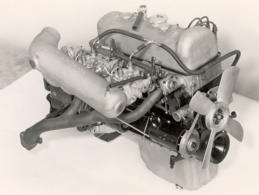

190 SL
# 5
# 4
# 3
# 2
# 1
Roadster
$25,500.00
$52,500.00
$83,000.00
$113,000.00
$150,300.00













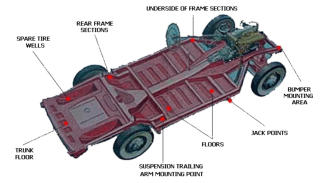
Technical Specifications
Engine Type:
4 cylinder (M121)
Bore and stroke:
85 x 83.6mm
Displacement:
1897 cc
Power output:
105 hp (DIN) @ 5700 rpm
Compression ratio:
8.5:1
Torque:
14.5 mkg @ 3200 rpm (104.9 ft/lb)
Carburetion:
2 dual downdraft carburetor Solex 44 PHH
Engine speed at 100km/hr:
3350 rpm
Gear ratios:
I. 352:1
II. 2.32:1
III.1.52:1
IV.1.00:1
Rear axle ratio:
3.90
Chassis:
unit frame and body
Suspension:
independent front, single joint swing axle rear, with coil springs
Brakes and area:
drum, 1064sq cm (servo optional)
Wheelbase:
2400 mm (112 inches)
Track front/rear:
1430/1475 mm (56.2/58.1 in)
Length:
4220 mm (166.1 inches)
Width:
1740 mm (68.5 inches)
Height:
1320 mm (52inches)
Ground clearance:
185 mm (7.3 inches)
Tires:
6.4 x 13 sport
Turning circle:
11 meters (36.1 feet)
Steering type and ratio:
recirculating ball, 18.5:1
Weight:
roadster: 2552 lbs
coupe: 2596
lbs
Maximum speed:
106 mph
Acceleration:
14.5 sec 0-100 km
Fuel consumption:
12.5 liters/100km (18.75 mpg)
Fuel tank capacity:
65 liters (17 gal.)
































































- 220 Cabriolet A and 220 Cabriolet B 1951-1955
- 300 -300b -300c - 300d Convertible Sedan 1951-1962
- 300S - 300Sc Cabriolet / Coupe / Roadster 1951-1958
- 300SL Gullwing and Roadster 1954-1962
- 190SL Roadsters 1955-1963
- 220S / 220SE Cabriolets & Coupes 1956-1960
- 300SE Cabriolets & Coupes 1962-1967
- 220SEb/250SE/280SE/280SE 3.5 Cabriolets & Coupes 1961-1971
- 230SL/250SL/280SL Roadsters 1963-1971













